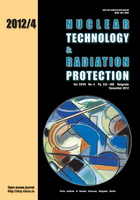
COMPLEMENTARY MEASUREMENTS OF RADON CONCENTRATION IN WATER SOURCES AND NATURAL EXPOSURE IN DWELLINGS IN THE VICINITY OF THE RAMSAR HLNRA, IRAN

Vol.
XXVII, No. 4, Pp. 333-408
December 2012
UDC 621.039+614.876:504.06
ISSN 1451-3994
Pages: 399-403
Authors: Mehrdad Amirzadi, Seyed Mahdi Hosseini Pooya, Mehran Taheri and
Asad Babakhani
Abstract
Tonekabon is a big city in the vicinity of the high level natural radiation area of Ramsar, Iran. Natural exposure due to gamma and radon concentration in 100 dwellings in the city has been measured using a thermoluminescent dosimeter and a radon diffusion chamber, respectively, over four seasons. Using active and passive methods (i. e. ZnS scintillation detectors and homemade radon diffusion chambers), the concentration of dissolved radon in water sources has been measured in both cities and frequency distributions of doses studied for radon measurements. Results show a daily average gamma dose of 4.2 ± 0.8 µSv and an average radon concentration in air of 232.5 ± 187 Bq/m3 in dwellings. Frequency distributions show that 85% of the dwellings have an average radon concentration of 100 to 300 Bq/m3 per year and that 80% have a maximum seasonal radon concentration of up to 400 Bq/m3. The maximum concentrations of dissolved radon in water in Ramsar and Tonekabon have been measured as 198 ±30 and 109 ± 16 BqL-1, respectively.
Key words: radon, high level natural radiation area, passive measurement
FULL PAPER IN PDF FORMAT (625 KB)